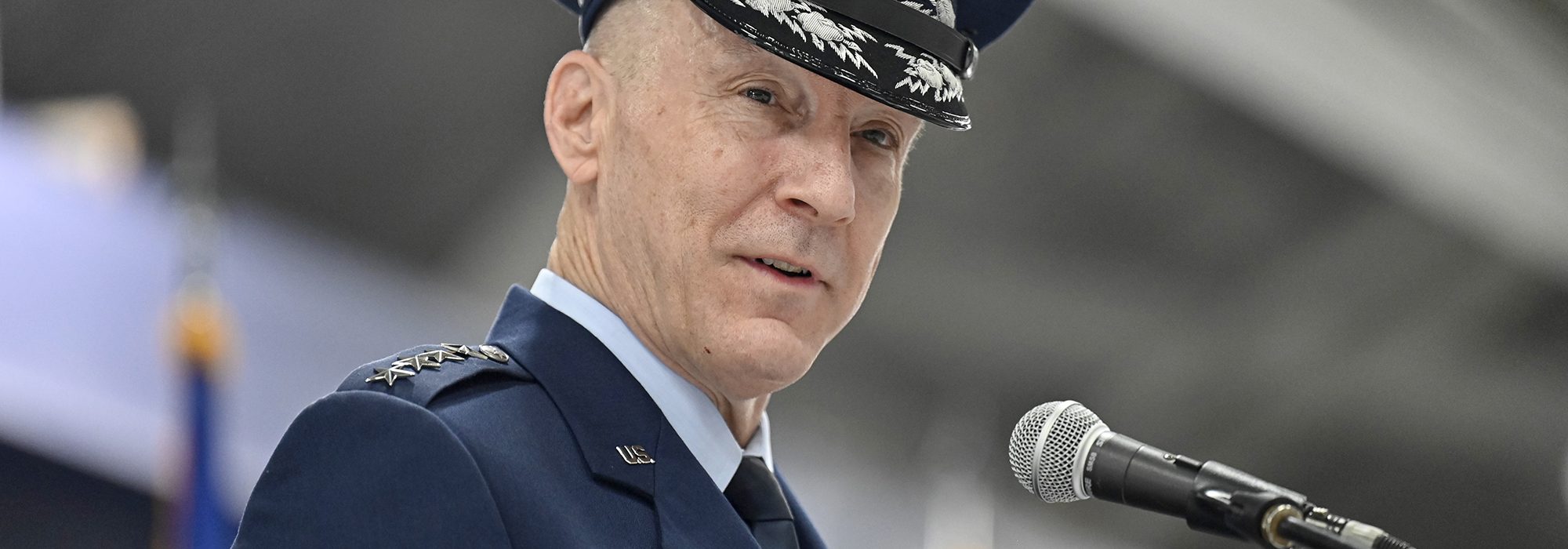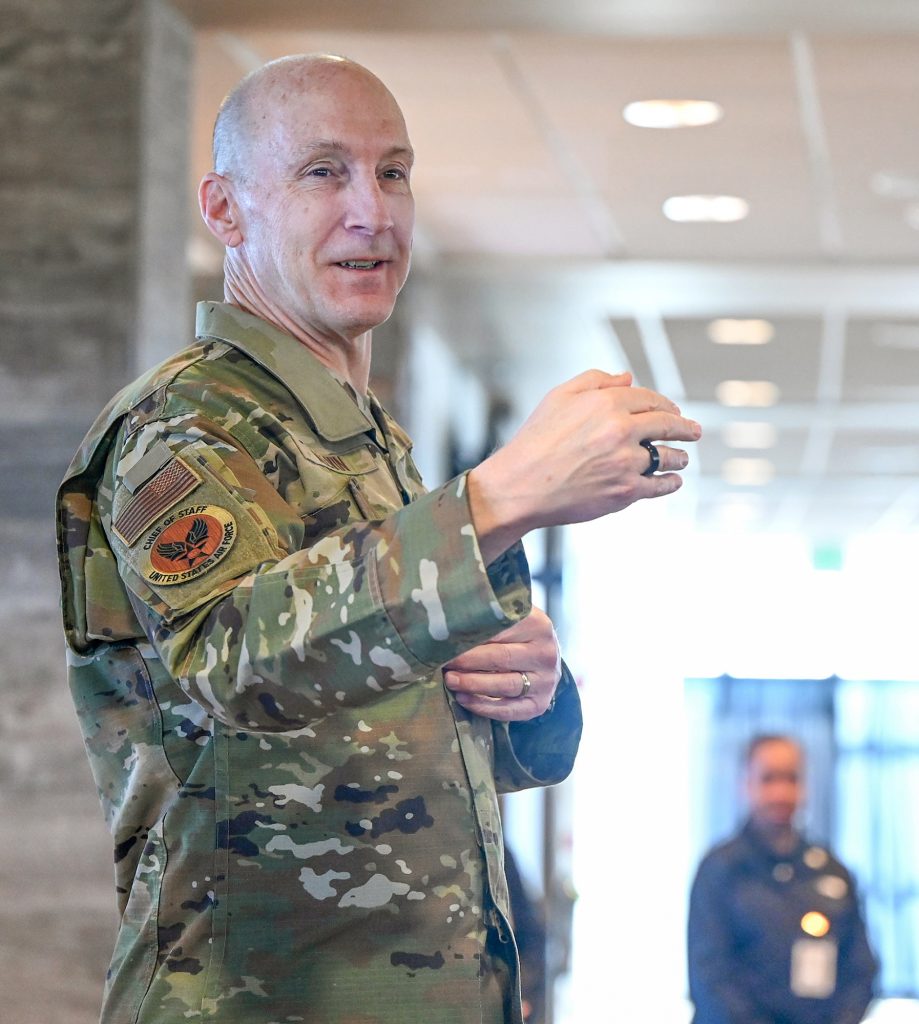Gen. David Allvin brings a different perspective to USAF’s top job, but the mission and key priorities are unchanged. His watchword remains ‘Follow Through.’
Among the first things you see when you enter Air Force Chief of Staff Gen. David W. Allvin’s office is a painting of a C-46 soaring across a foreboding sky as lightning flashes in the background. The picture tells a story, Allvin says: “There’s some trouble ahead. We need to pierce that and get through it and get to the other side.”
It is a not-so-subtle metaphor for the challenges facing the 23rd Air Force Chief of Staff as he leads the service into an uncertain future. In the midst of an ambitious restructuring of the Department of the Air Force, with rising conflict around the world and a dangerous peer competitor in China, yet an uncertain budgetary environment at home, Allvin is taking over at a pivotal moment.
Russia’s ongoing war in Ukraine, skirmishes in the Middle East, and the emerging ties linking China, Russia, and Iran make already complex international situations fraught. Iran is fueling terror groups that threaten to expand Israel’s war on Hamas in the Gaza Strip into a regional conflict on multiple fronts. Beijing is flexing its muscles in the Western Pacific and eyeing Taiwan, while Moscow is doubling down on its war in Ukraine, leveraging weapons made in Iran and paid for with oil revenue from China.
Air Force Chief of Staff Gen. David AllvinFor the past two decades, “we didn’t have … a potential adversary and a pacing challenge. … We have that now.
“We’re at a point where all of the things are there to go one of two directions,” Allvin said in an interview with Air & Space Forces Magazine, his first interview as Chief. If the U.S. rises to the challenge, it can preserve its global role. But there is also a darker path in which the U.S. could be “ground down” and where rivals could start “taking advantage of that.”
If the U.S. harnesses it’s full array of economic, diplomatic, informational, and military capabilities, it can sustain the rules-based international order, Allvin said. But if it cannot, “we’re at risk of becoming a regional power in 2050.”
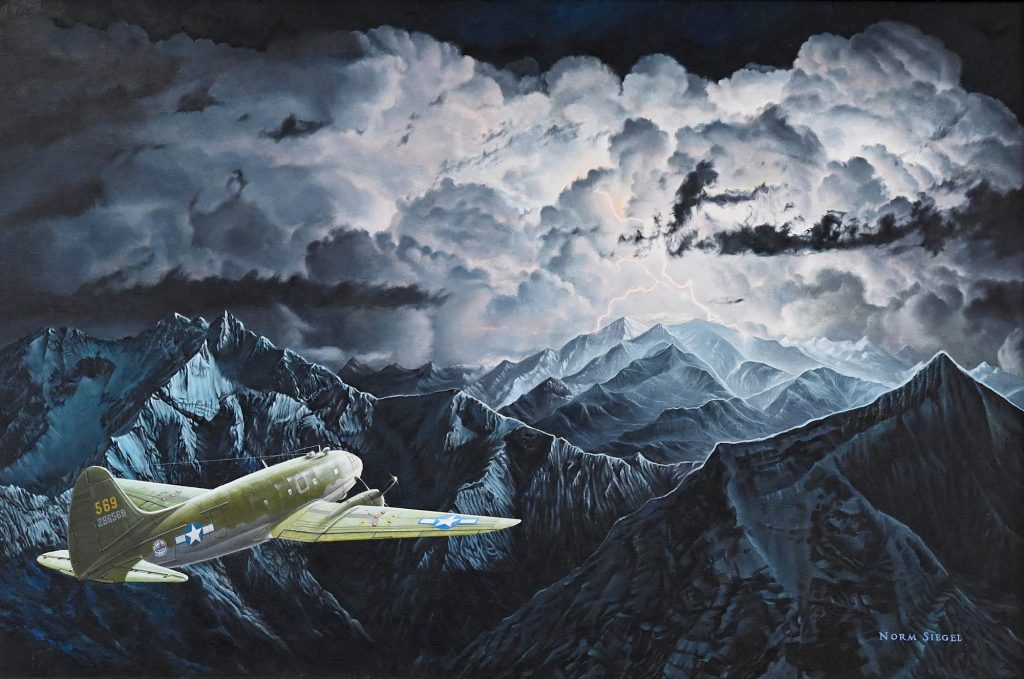
The end of the American era would be a major failure for the nation, let alone the military. But the choice is really in the hands of America’s elected leaders, both in the White House and in Congress. Military power is never permanent but must be perpetually renewed, Allvin said.
“It will be a struggle for the rest of our instruments of power to maintain the freedoms and ambitions that this country holds dear if we don’t do our part as a Department of Defense,” Allvin stated.
Shaved headed and clean faced, gentle in manner and tone, Allvin can seem an unlikely choice to be Air Force Chief of Staff. His career path is hardly a textbook example of CSAF development. But as the eighth of nine children, he grew up watching and learning from others, and then applied that experience to a career as a mobility and test pilot.
About one in every six of his 4,600 flight hours came during a test flight, exacting missions in which he evaluated new systems and equipment, including test flights in the then-new C-17 and C-130J at Edwards Air Force Base, Calif.
Allvin never led an Air Force major command, having spent the past decade in senior staff jobs, completing his last command post in 2014 at the 618th Air and Space Operations Center (Tanker Airlift Control Center), at Scott Air Force Base, Ill.
Yet Allvin may be as well prepared for his role as any Chief in years, having worked closely with his three predecessors, on the Joint Staff and overseas. Current and retired officers say he is well positioned to be a difference maker at a critical time.
“What you flew or what you did in the first 10 years of your career is interesting, but I am less concerned about what someone did in the early years of their career than their ability to make decisions about what’s in the best interest of the Air Force as an entire enterprise,” said retired Lt. Gen. David A. Deptula, a former F-15 pilot who also spent extensive time on the Air Staff and is now dean at AFA’s Mitchell Institute for Aerospace Studies.
“His approach is a mature one and appropriate for the times.”
As Gen. Charles Q. Brown Jr.’s deputy, Allvin worked quietly and for a while almost invisibly behind the scenes, focusing on Secretary Frank Kendall’s operational imperatives and leading a task force that tackled recruiting challenges by removing barriers to service that barred some deserving candidates from joining. That work gave him an intimate understanding of the bureaucratic and institutional obstacles that may need to be flattened as the Air Force optimizes and adapts to the coming era. “General Allvin thinks on multiple levels at the same time,” said retired Lt. Gen. S. Clinton Hinote, a former deputy chief of staff for strategy, integration, and requirements who retired last June. “His experience as Vice Chief is irreplaceable. And he is already deeply invested in many of the solutions identified and being pursued by the Secretary.”
Forward Thinking
Allvin began thinking about the changing security environment long before it became fashionable to strategize about great power competition.
In his 1999 graduate thesis, “Paradigm Lost,” Allvin argued the Air Force had grown dependent on its large bases and that it needed to become more flexible and able to operate in “austere” locations. A quarter-century later, his tome seems prescient. Allvin was arguing for how the Air Force could better support the Army’s vision of a more agile future force—before that service got bogged down in ground wars in Afghanistan and Iraq.
Today, his thesis reads like something freshly penned by a four-star commander singing the virtues of Agile Combat Employment, now established doctrine, rather than a midlevel officer pondering the future. In it, young Allvin predicted “more reliance on information, dispersed forces, and increased dependence on maneuver,” and anticipated “new logistical challenges will emerge, placing increased importance on the principles of flexibility and survivability.”
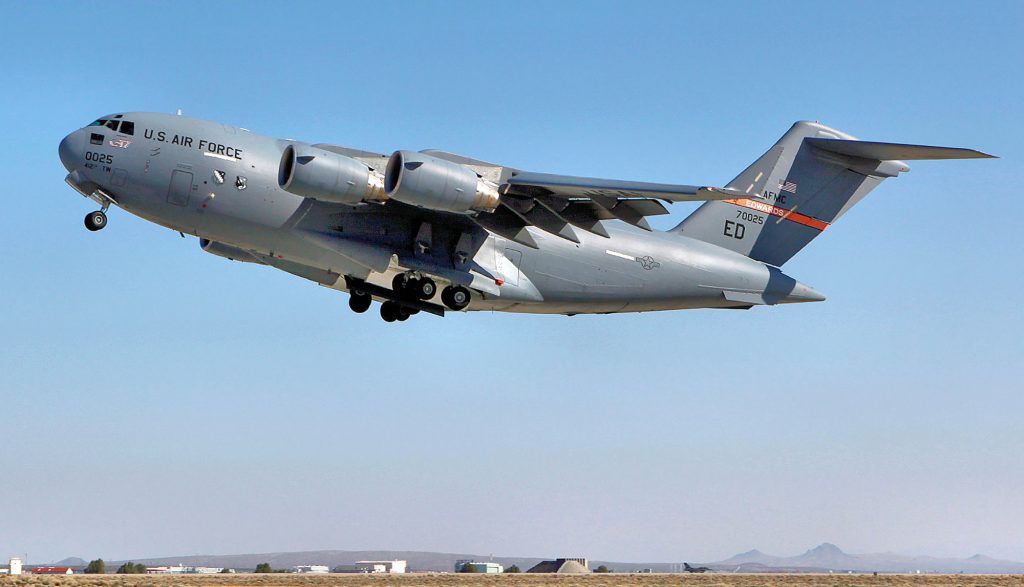
Even now, Allvin harks back to his time as a graduate student at the School of Advanced Airpower Studies at Maxwell Air Force Base, Ala., when asked what drives his thinking.
Maxwell Field was the birthplace of the so-called “Bomber Mafia,” the idealistic Army Air Corps Airmen who used the period between the world wars to devise airpower concepts and who envisioned an era of precision bombing, decades and decades before that was truly possible. In the 1990s, more than half a century later, Allvin was eager to pioneer his own legacy.
“I thought I was going there to become an airpower strategist and expert—that’s where I wanted to do it,” Allvin said. He emerged “a better critical thinker,” he added, unafraid to explore alternative perspectives.
Asking questions of others, considering new angles, he can surprise colleagues, he said. “Sometimes people look at me and go, ‘I didn’t know you felt that way.’ Well, I may not feel that way,” Allvin said. “I just want to understand. I want to live in that world. …
“I like to connect dots, so when I see a particular issue, I try and look at the unintended consequences of it, the advantage of it,” Allvin added. “I know that sometimes your own wisdom and experience can trap you in a century gone by.”
Allvin’s thesis became irrelevant in a sense on Sept. 11, 2001. Everything changed after that, not least the Army’s and Air Force’s modernization plans. War in Afghanistan opened the way to war in Iraq, and then two decades of “Forever Wars” that wore out Air Force platforms and starved the service of modernization funds. Allvin’s first assignment as a general officer was to lead the NATO personnel training the Afghan Air Force in 2010-2011, a tough assignment. In the midst of it, an Afghan Air Force officer turned on his allies, killing nine Americans in a green-on-blue attack on April 27, 2011.
From there, Allvin moved through assignments on the Joint Staff or Air Staff, including multiple senior Air Force strategic planning posts before rising to become the JCS’s director for strategy, plans, and policy (J5) before being picked as the USAF’s No. 2 officer.
Meanwhile, the Air Force, operating with the presumption of air dominance, doubled down on large bases rather than the agile concepts Allvin outlined in the late 1990s. Al Udeid Air Base outside Doha, Qatar, symbolized the sprawling, multibillion-dollar bases that now seem vulnerable in other parts of the world, home to both a massive Combined Air Operations Center and the forward headquarters of U.S. Central Command.
Allvin sees the irony. One subheading in Allvin’s thesis reads “Don’t be killed,” a clear reference to the risks posed by large static bases.
“He’s able to think past the problem into a solution, and he can see all the second- and third-order effects pretty quickly,” said a senior Air Force officer who has worked closely with Allvin. “He’s always got a mind on the future and making sure that the decisions we make today aren’t trapped in the environment of today.”
Changing Times
Airmen argued long and hard for more focus on potential threats from China, dating back to the early 2000s. But as the wars in Iraq and Afghanistan deteriorated, such talk was dismissed by Pentagon leadership, especially by Defense Secretary Robert Gates, whose tenure overlapped the end of President George Bush’s second term and the first part of President Barack Obama’s presidency.
A year after President Donald J. Trump was inaugurated, Secretary James Mattis, a veteran of the Iraq and Afghan wars, issued the 2018 National Defense Strategy, refocusing attention on great power competition and on China in particular. The Biden administration’s 2022 update further emphasized China, dubbing the People’s Liberation Army “the pacing challenge.”
Then-Chairman of the Joint Chiefs of Staff Army Gen. Mark A. Milley responded with a new Joint Warfighting Concept, updating it again in August 2023, just ahead of Milley’s retirement and replacement by Brown.
For the past two decades, Allvin said, “We didn’t have an environment—a potential adversary and a pacing challenge—against which to align all of the department. We have that now.”
As Vice Chief, Allvin was immersed in the future requirements of the U.S. military as a member of the Joint Requirements Oversight Council (JROC), along with his fellow Vice Chiefs, among them the new Chiefs of his sister services: Chief of Naval Operations Adm. Lisa Franchetti, Army Chief of Staff Gen. Randy Alan George, and Commandant of the Marine Corps Gen. Eric Smith.
That group took the JROC and bent it more to their liking, Allvin said.
“It wasn’t always a very muscular entity,” Allvin said of the JROC. “But we flipped the script on that and are really being more disciplined about putting joint requirements on capabilities. … By the end of it, we started finishing each other’s sentences in terms of the value of how to do things.”
As Chief, Allvin will try to bring that kind of collaborative spirit to the stovepiped Air Force structure, especially at the three annual CORONA summits that bring all the Air Force four-stars together. The meetings can sometimes be contentious affairs, but the fall 2023 CORONA held at the U.S. Air Force Academy in Colorado Springs, Colo., was an intensive problem-solving effort. (Having begun with Allvin as the Acting Chief, due to legislative delays, he was finally confirmed and sworn in half-way through the event.)
This CORONA was different for other reasons. Rather than brief preformulated decisions, the service’s top officers debated the future of the service itself, according to those present—a direct outgrowth of Secretary Kendall’s charge to “re-optimize” the service to more rapidly adapt for potential conflict with China.
“It was designed to be a roll-up-your-sleeves [session],” said the current senior Air Force officer. “Unlike previous CORONAs, where items are teed up … we went into this one wide-eyed, knowing that this was going to be a series of working sessions to understand where we were in all the great power competition efforts.”
With Kendall having set a self-imposed deadline of early 2024 to study all the institutions, practices, and procedures that might need changing, top Air Force and Space Force officers had little time to waste. Allvin, the presumed next Chief, was not quite in charge, and it looked as if the congressional hold imposed by Sen. Tommy Tuberville (R-Ala.) might continue indefinitely. Tuberville lifted his hold and the upper chamber quickly confirmed the top leaders for the Air Force and Navy. Allvin was sworn in as Chief No. 23 on Nov. 2, 2023, in the press box at Falcon Stadium, overlooking the field where Allvin was commissioned 36 years before. Afterward, he gave a brief, impromptu speech, speaking without notes, as usual.
In the days after, Allvin crafted his first message to the force, emphasizing the need not for new ideas and new direction, but to complete the work begun under his predecessors, in particular Gen. Mark Welsh, Gen. David Goldfein, and Brown, all of whom Allvin served and all of whom advanced ideas that are central to his vision for the Air Force: integrated joint operations. Agile maneuver. Superior intelligence. His central message: “Follow through.”
That resonates with Hinote, among others.
“I’ve watched Airmen give up on big things because a new Chief came in with different points of emphasis,” Hinote said. “He didn’t come in and present a new slate of priorities.”
Instead, he is driving to stay the course, noting that the course he helped set already has the Air Force moving in the right direction. That has Hinote particularly hopeful. “If he is successful in doing the things he identifies in his initial letter, he will be the most consequential CSAF since [Gen. Merrill “Tony”] McPeak,” Hinote said, referring to the Air Force’s 14th Chief of Staff, whose 1990-1994 tenure upended the Air Force following the end of the Cold War and Operation Desert Storm, with controversial decisions to reorganize, downsize, and reconfigure the entire force.
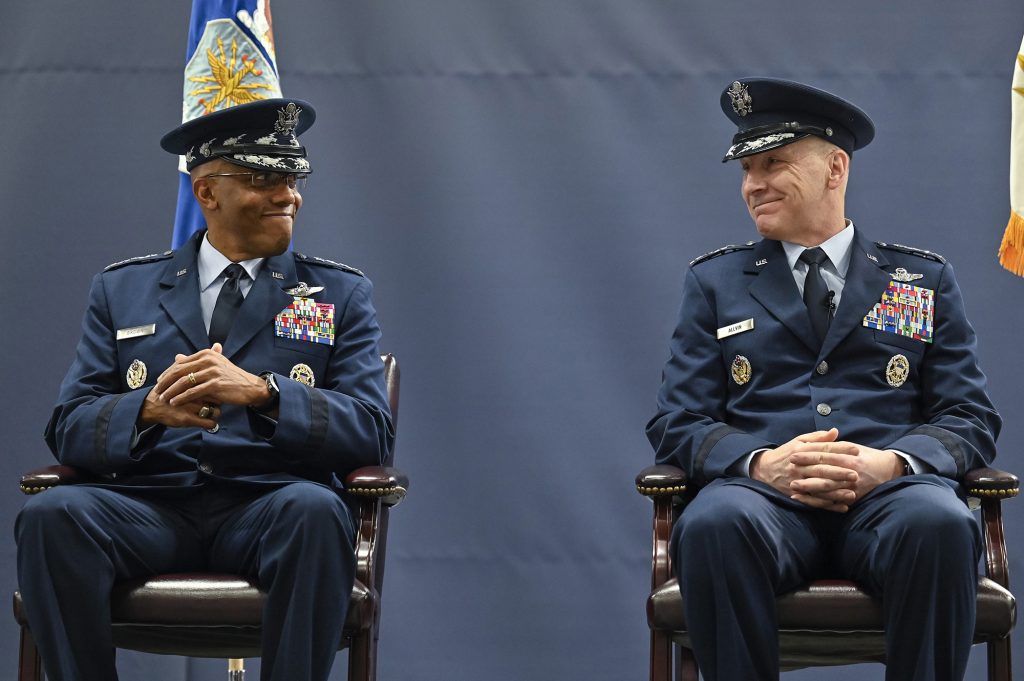
The world was changing then, and McPeak saw the change as an opportunity to reimagine airpower. Allvin sees similar forcing factors today. The world is changing and the Air Force must change, too.
“The most important thing I would like all of our Airmen to understand is why we have to change,” Allvin said. “Not in a way that says the sky is falling, and everything is terrible, but in a cautionary way. … It could be awesome if we get this right and it could be the Air Force that we want it to be. The environment has changed. The Air Force has been slow to catch up to it. But we’ve got all the good ideas. Now we just need to apply the gas to it and be not afraid to make decisions and fail forward.”
The fact is no one has a crystal ball. No one knows what the future will bring. But not trying leaves a nation flat-footed. Effort is essential to avoid that fate.
“Everybody gets the future wrong,” Allvin said. “Whoever gets it right quicker wins.”
